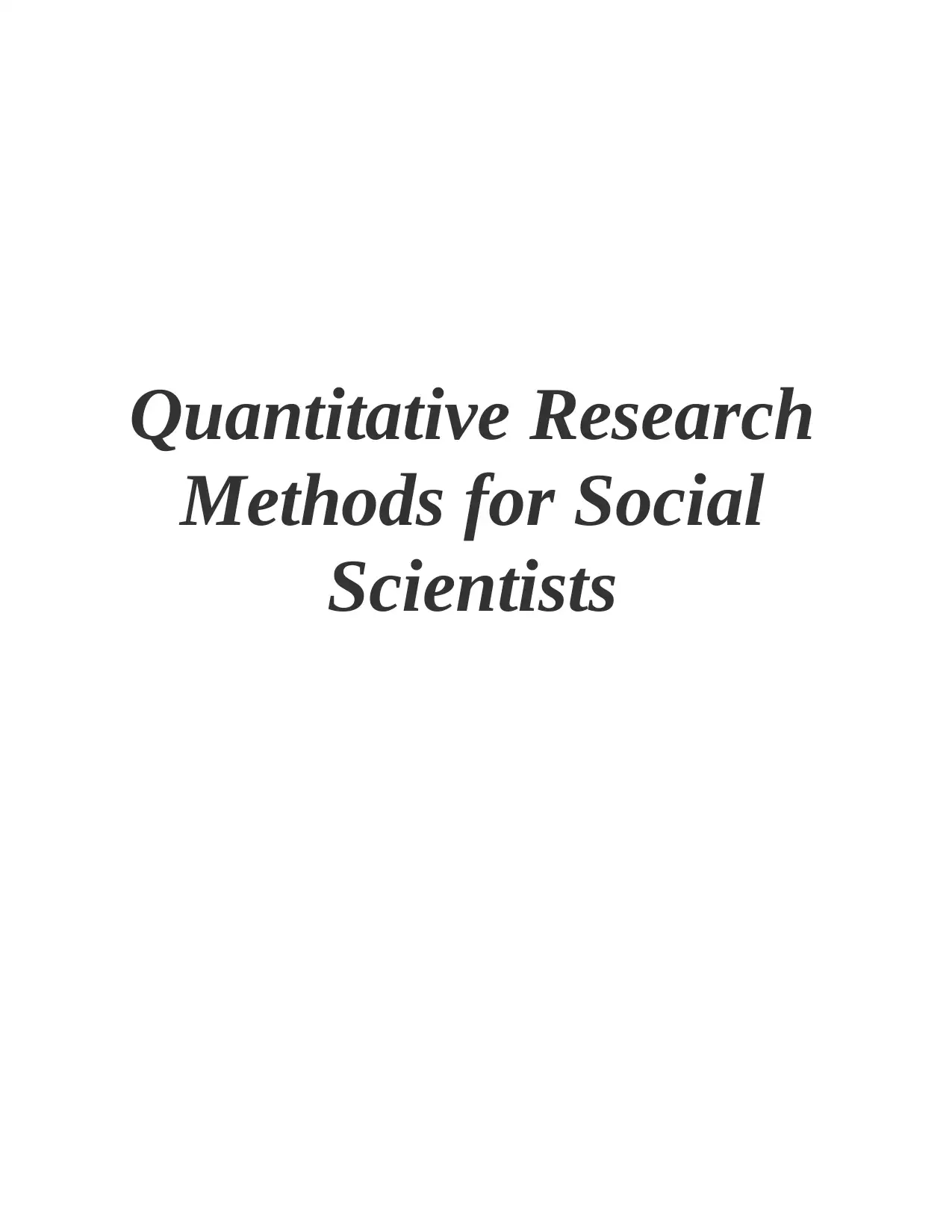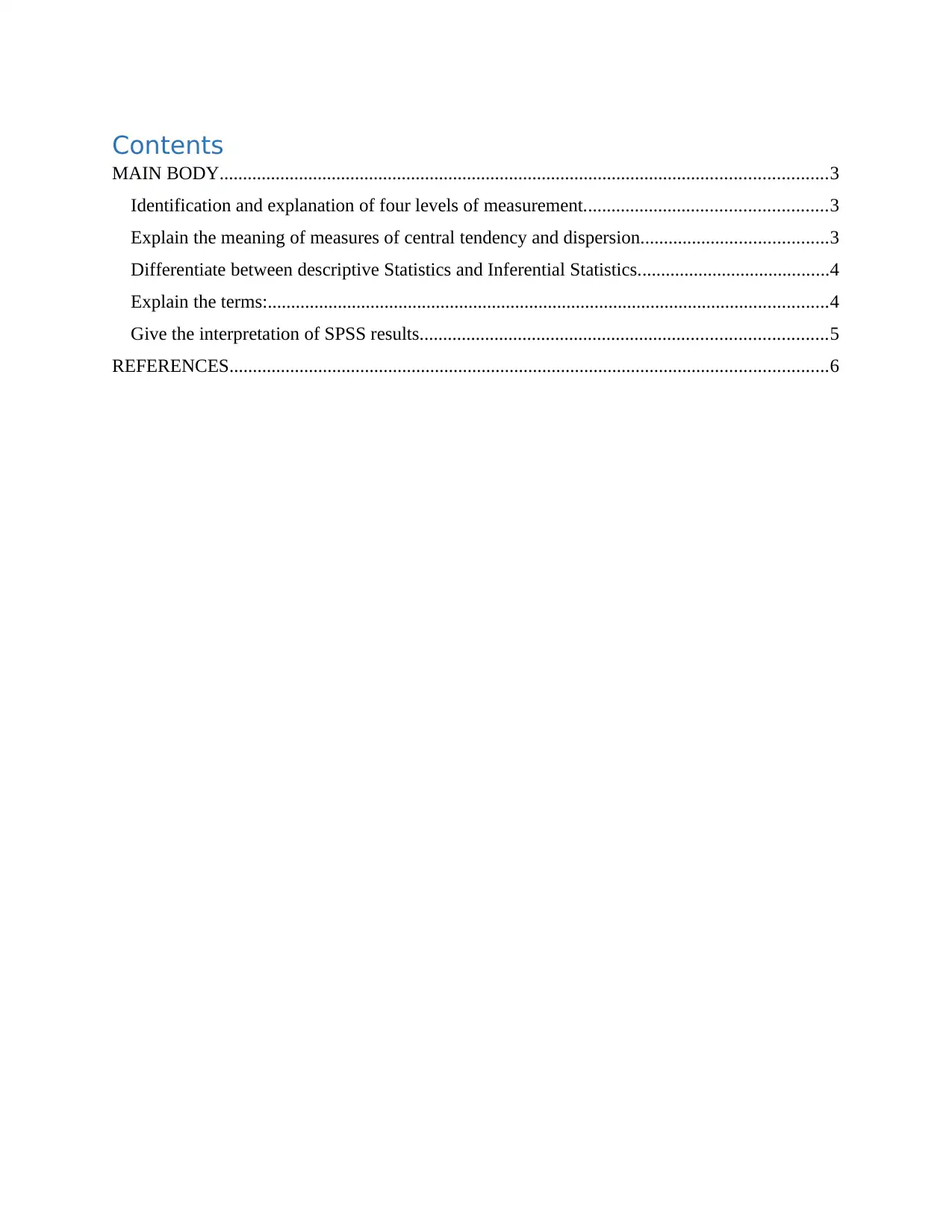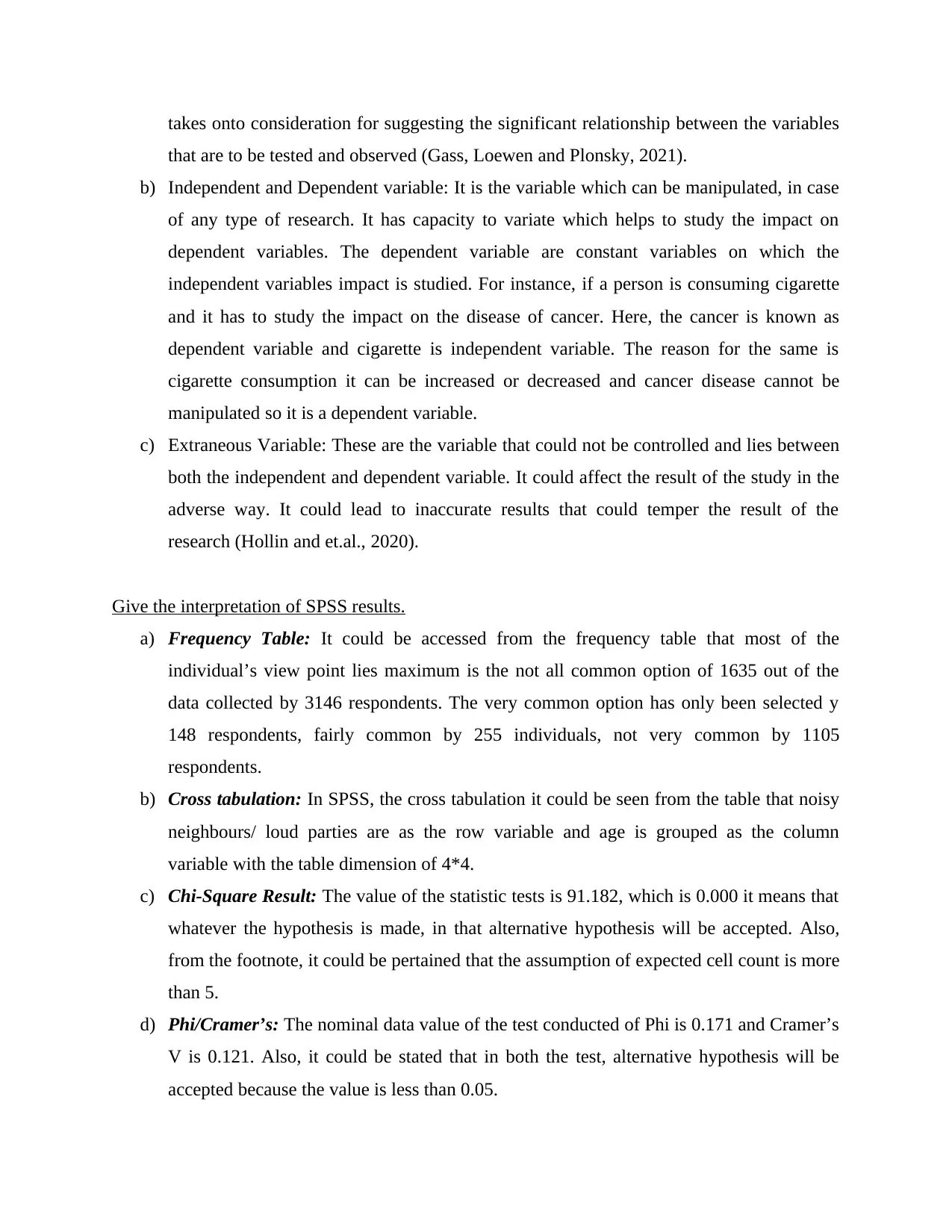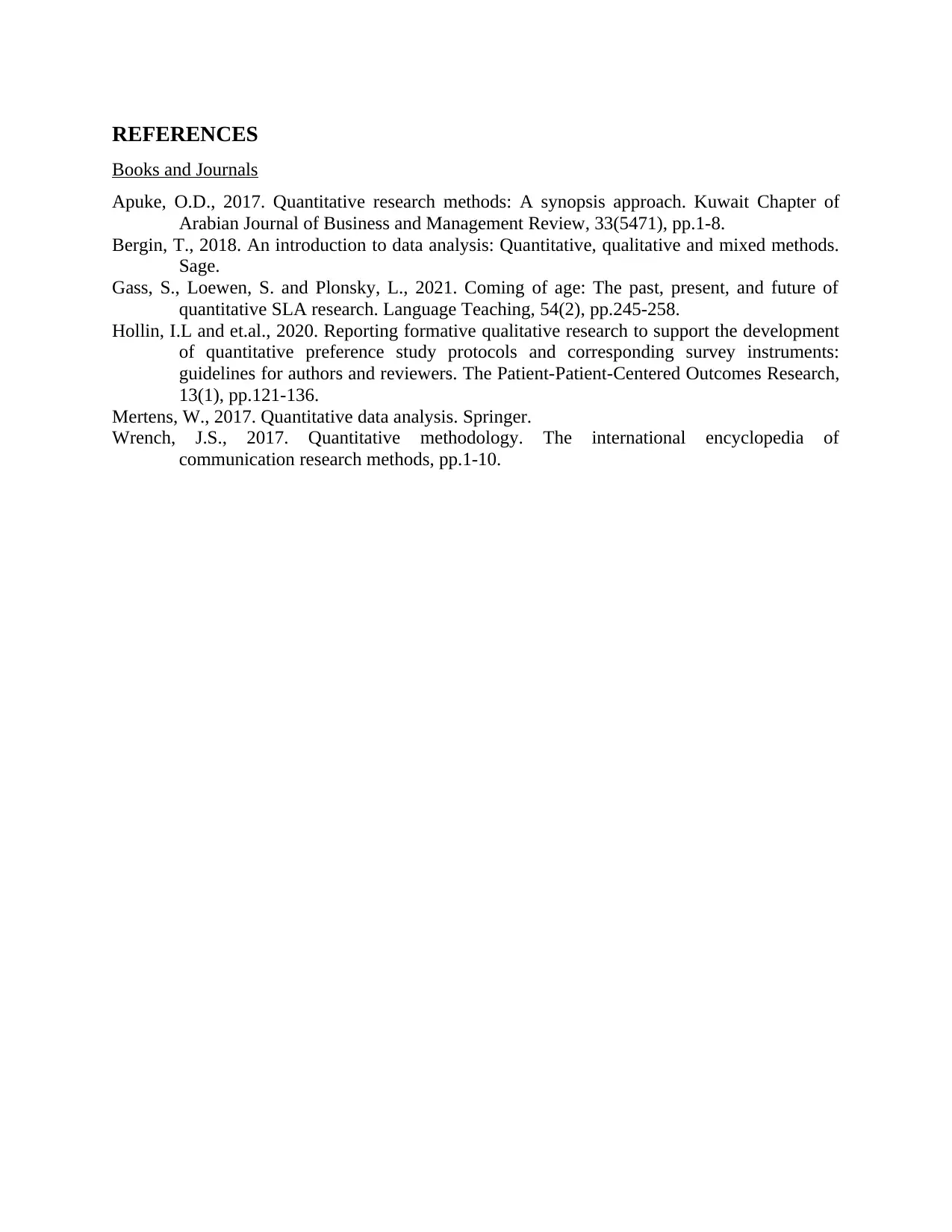Analysis of Quantitative Research Methods for Social Scientists
VerifiedAdded on 2023/06/12
|7
|1387
|369
Report
AI Summary
This report provides a detailed overview of quantitative research methods for social scientists. It identifies and explains the four levels of measurement: nominal, ordinal, interval, and ratio, providing examples for each. The report defines measures of central tendency (mean, median, mode) and dispersion (range, standard deviation, variance). It differentiates between descriptive and inferential statistics, outlining their respective purposes and techniques. Key terms such as hypothesis, null hypothesis, independent and dependent variables, and extraneous variables are explained. The report also includes an interpretation of SPSS results, covering frequency tables, cross-tabulation, Chi-square tests, and Phi/Cramer's V, with explanations of how to interpret the statistical significance of the findings. The document concludes with a list of references used in the analysis.

Quantitative Research
Methods for Social
Scientists
Methods for Social
Scientists
Paraphrase This Document
Need a fresh take? Get an instant paraphrase of this document with our AI Paraphraser

Contents
MAIN BODY..................................................................................................................................3
Identification and explanation of four levels of measurement....................................................3
Explain the meaning of measures of central tendency and dispersion........................................3
Differentiate between descriptive Statistics and Inferential Statistics.........................................4
Explain the terms:........................................................................................................................4
Give the interpretation of SPSS results.......................................................................................5
REFERENCES................................................................................................................................6
MAIN BODY..................................................................................................................................3
Identification and explanation of four levels of measurement....................................................3
Explain the meaning of measures of central tendency and dispersion........................................3
Differentiate between descriptive Statistics and Inferential Statistics.........................................4
Explain the terms:........................................................................................................................4
Give the interpretation of SPSS results.......................................................................................5
REFERENCES................................................................................................................................6

MAIN BODY
Identification and explanation of four levels of measurement.
Levels of measurement assists in the identification and categorization of the values within the
facts and figure set collected from the statistical tools like surveys and questionnaire. The four
levels of measurement are described as below-
Nominal- This scale is used with the aim of classification. The figures linked with this
scale are marked for division only. They have no numerical relevance so the calculation
of such figures is pointless (Apuke, 2017).
For example- If a survey is conducted for the brand preference of televisions: and the options
are- “Sony”-1, “Haier”-2, “LG”-3. In this the brand name is important for the researcher and not
the numbers. If the respondent prefers Sony, then the data will be entered as-1. This helps in
getting the number of how many people prefer Sony, how many people went for Haier, and the
number of respondents for LG. This helps in getting the highest preference.
Ordinary Scale – This level is used to represent the order of variables.
For example- The survey for the customer satisfaction with the options- 1- Totally satisfied, 2-
satisfied, 3- neutral, 4- dissatisfied. The respondents will choose between these options. Thus, it
can be said that it is the parameter that is used to compare the greater and lesser variables.
Interval scales- This scale delivers assurance with the difference between the figures are
equal.
For example- The variance between an IQ 30 and 40 is 10 which is same as the difference
between 80 and 90.
Ratio Scales- These scales provide valuable insights like rankings, this also assure the
equal differences between the level.
For example- If a man is 60 years old and his son is 30 years old. Then it can be interpreted that
the man is twice of his son's age.
Explain the meaning of measures of central tendency and dispersion.
The measure of central tendency is used for making the use of the statistical techniques
approximately estimating through various medium that how much the data has been distributed.
Identification and explanation of four levels of measurement.
Levels of measurement assists in the identification and categorization of the values within the
facts and figure set collected from the statistical tools like surveys and questionnaire. The four
levels of measurement are described as below-
Nominal- This scale is used with the aim of classification. The figures linked with this
scale are marked for division only. They have no numerical relevance so the calculation
of such figures is pointless (Apuke, 2017).
For example- If a survey is conducted for the brand preference of televisions: and the options
are- “Sony”-1, “Haier”-2, “LG”-3. In this the brand name is important for the researcher and not
the numbers. If the respondent prefers Sony, then the data will be entered as-1. This helps in
getting the number of how many people prefer Sony, how many people went for Haier, and the
number of respondents for LG. This helps in getting the highest preference.
Ordinary Scale – This level is used to represent the order of variables.
For example- The survey for the customer satisfaction with the options- 1- Totally satisfied, 2-
satisfied, 3- neutral, 4- dissatisfied. The respondents will choose between these options. Thus, it
can be said that it is the parameter that is used to compare the greater and lesser variables.
Interval scales- This scale delivers assurance with the difference between the figures are
equal.
For example- The variance between an IQ 30 and 40 is 10 which is same as the difference
between 80 and 90.
Ratio Scales- These scales provide valuable insights like rankings, this also assure the
equal differences between the level.
For example- If a man is 60 years old and his son is 30 years old. Then it can be interpreted that
the man is twice of his son's age.
Explain the meaning of measures of central tendency and dispersion.
The measure of central tendency is used for making the use of the statistical techniques
approximately estimating through various medium that how much the data has been distributed.
⊘ This is a preview!⊘
Do you want full access?
Subscribe today to unlock all pages.

Trusted by 1+ million students worldwide

For this the main techniques of central tendency used is of the mean, median and mode (Mertens,
2017).
The measure of dispersion identifies the techniques that are used for find out that how
much the data has been spread. It could be found through the help of the techniques of inter
quartile deviation, standard deviation, variance analysis, range.
Differentiate between descriptive Statistics and Inferential Statistics.
The descriptive statistics is main performed through the main statistical functions in which
the target has already been identified and the computation are performed accordingly. Whereas,
inferential statistics helps in making decisions. It enhances the productivity of the organisation as
well.
Descriptive Statistics Inferential Statistics
Only identifies and present the data It generalises the data information by
analysing it.
The data is organised, analysed and then
presented in the table format or other way so
that could be presented well.
It predicts the future outcomes by comparison
various types of tests.
The outcomes generated are framed in the
form of graphs, tables and charts.
The results are found out here on the basis of
the probability and significance value
(Wrench, 2017).
It only elaborates the data which is already
known
It helps in making conclusions about the data
that has been presented.
The techniques used here are: Mean, mode,
median, standard deviation, range.
Here the use of hypothesis is done and the
tests done is: Z – test, t- test and many other.
Explain the terms:
a) Hypothesis and Null Hypothesis: The Hypothesis is the assumption that is taken to
conduct any research or study for completing or satisfying the objectives of the study. It
could be tested for identifying that the hypothesis created and the assumption taken is
true or false. Null Hypothesis could be explained by defining the statistical theory which
2017).
The measure of dispersion identifies the techniques that are used for find out that how
much the data has been spread. It could be found through the help of the techniques of inter
quartile deviation, standard deviation, variance analysis, range.
Differentiate between descriptive Statistics and Inferential Statistics.
The descriptive statistics is main performed through the main statistical functions in which
the target has already been identified and the computation are performed accordingly. Whereas,
inferential statistics helps in making decisions. It enhances the productivity of the organisation as
well.
Descriptive Statistics Inferential Statistics
Only identifies and present the data It generalises the data information by
analysing it.
The data is organised, analysed and then
presented in the table format or other way so
that could be presented well.
It predicts the future outcomes by comparison
various types of tests.
The outcomes generated are framed in the
form of graphs, tables and charts.
The results are found out here on the basis of
the probability and significance value
(Wrench, 2017).
It only elaborates the data which is already
known
It helps in making conclusions about the data
that has been presented.
The techniques used here are: Mean, mode,
median, standard deviation, range.
Here the use of hypothesis is done and the
tests done is: Z – test, t- test and many other.
Explain the terms:
a) Hypothesis and Null Hypothesis: The Hypothesis is the assumption that is taken to
conduct any research or study for completing or satisfying the objectives of the study. It
could be tested for identifying that the hypothesis created and the assumption taken is
true or false. Null Hypothesis could be explained by defining the statistical theory which
Paraphrase This Document
Need a fresh take? Get an instant paraphrase of this document with our AI Paraphraser

takes onto consideration for suggesting the significant relationship between the variables
that are to be tested and observed (Gass, Loewen and Plonsky, 2021).
b) Independent and Dependent variable: It is the variable which can be manipulated, in case
of any type of research. It has capacity to variate which helps to study the impact on
dependent variables. The dependent variable are constant variables on which the
independent variables impact is studied. For instance, if a person is consuming cigarette
and it has to study the impact on the disease of cancer. Here, the cancer is known as
dependent variable and cigarette is independent variable. The reason for the same is
cigarette consumption it can be increased or decreased and cancer disease cannot be
manipulated so it is a dependent variable.
c) Extraneous Variable: These are the variable that could not be controlled and lies between
both the independent and dependent variable. It could affect the result of the study in the
adverse way. It could lead to inaccurate results that could temper the result of the
research (Hollin and et.al., 2020).
Give the interpretation of SPSS results.
a) Frequency Table: It could be accessed from the frequency table that most of the
individual’s view point lies maximum is the not all common option of 1635 out of the
data collected by 3146 respondents. The very common option has only been selected y
148 respondents, fairly common by 255 individuals, not very common by 1105
respondents.
b) Cross tabulation: In SPSS, the cross tabulation it could be seen from the table that noisy
neighbours/ loud parties are as the row variable and age is grouped as the column
variable with the table dimension of 4*4.
c) Chi-Square Result: The value of the statistic tests is 91.182, which is 0.000 it means that
whatever the hypothesis is made, in that alternative hypothesis will be accepted. Also,
from the footnote, it could be pertained that the assumption of expected cell count is more
than 5.
d) Phi/Cramer’s: The nominal data value of the test conducted of Phi is 0.171 and Cramer’s
V is 0.121. Also, it could be stated that in both the test, alternative hypothesis will be
accepted because the value is less than 0.05.
that are to be tested and observed (Gass, Loewen and Plonsky, 2021).
b) Independent and Dependent variable: It is the variable which can be manipulated, in case
of any type of research. It has capacity to variate which helps to study the impact on
dependent variables. The dependent variable are constant variables on which the
independent variables impact is studied. For instance, if a person is consuming cigarette
and it has to study the impact on the disease of cancer. Here, the cancer is known as
dependent variable and cigarette is independent variable. The reason for the same is
cigarette consumption it can be increased or decreased and cancer disease cannot be
manipulated so it is a dependent variable.
c) Extraneous Variable: These are the variable that could not be controlled and lies between
both the independent and dependent variable. It could affect the result of the study in the
adverse way. It could lead to inaccurate results that could temper the result of the
research (Hollin and et.al., 2020).
Give the interpretation of SPSS results.
a) Frequency Table: It could be accessed from the frequency table that most of the
individual’s view point lies maximum is the not all common option of 1635 out of the
data collected by 3146 respondents. The very common option has only been selected y
148 respondents, fairly common by 255 individuals, not very common by 1105
respondents.
b) Cross tabulation: In SPSS, the cross tabulation it could be seen from the table that noisy
neighbours/ loud parties are as the row variable and age is grouped as the column
variable with the table dimension of 4*4.
c) Chi-Square Result: The value of the statistic tests is 91.182, which is 0.000 it means that
whatever the hypothesis is made, in that alternative hypothesis will be accepted. Also,
from the footnote, it could be pertained that the assumption of expected cell count is more
than 5.
d) Phi/Cramer’s: The nominal data value of the test conducted of Phi is 0.171 and Cramer’s
V is 0.121. Also, it could be stated that in both the test, alternative hypothesis will be
accepted because the value is less than 0.05.

⊘ This is a preview!⊘
Do you want full access?
Subscribe today to unlock all pages.

Trusted by 1+ million students worldwide

REFERENCES
Books and Journals
Apuke, O.D., 2017. Quantitative research methods: A synopsis approach. Kuwait Chapter of
Arabian Journal of Business and Management Review, 33(5471), pp.1-8.
Bergin, T., 2018. An introduction to data analysis: Quantitative, qualitative and mixed methods.
Sage.
Gass, S., Loewen, S. and Plonsky, L., 2021. Coming of age: The past, present, and future of
quantitative SLA research. Language Teaching, 54(2), pp.245-258.
Hollin, I.L and et.al., 2020. Reporting formative qualitative research to support the development
of quantitative preference study protocols and corresponding survey instruments:
guidelines for authors and reviewers. The Patient-Patient-Centered Outcomes Research,
13(1), pp.121-136.
Mertens, W., 2017. Quantitative data analysis. Springer.
Wrench, J.S., 2017. Quantitative methodology. The international encyclopedia of
communication research methods, pp.1-10.
Books and Journals
Apuke, O.D., 2017. Quantitative research methods: A synopsis approach. Kuwait Chapter of
Arabian Journal of Business and Management Review, 33(5471), pp.1-8.
Bergin, T., 2018. An introduction to data analysis: Quantitative, qualitative and mixed methods.
Sage.
Gass, S., Loewen, S. and Plonsky, L., 2021. Coming of age: The past, present, and future of
quantitative SLA research. Language Teaching, 54(2), pp.245-258.
Hollin, I.L and et.al., 2020. Reporting formative qualitative research to support the development
of quantitative preference study protocols and corresponding survey instruments:
guidelines for authors and reviewers. The Patient-Patient-Centered Outcomes Research,
13(1), pp.121-136.
Mertens, W., 2017. Quantitative data analysis. Springer.
Wrench, J.S., 2017. Quantitative methodology. The international encyclopedia of
communication research methods, pp.1-10.
1 out of 7
Related Documents
Your All-in-One AI-Powered Toolkit for Academic Success.
+13062052269
info@desklib.com
Available 24*7 on WhatsApp / Email
![[object Object]](/_next/static/media/star-bottom.7253800d.svg)
Unlock your academic potential
Copyright © 2020–2025 A2Z Services. All Rights Reserved. Developed and managed by ZUCOL.


